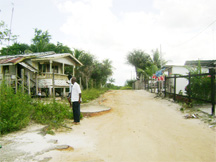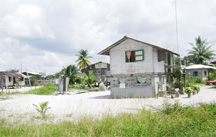North Timehri could just as easily have been called Samsville or Samstown as there have been Sams living there longer than the current airport has been where it is.
“I remember as a young boy standing up and watching the casting being done for the airport. And now they want to move us,” Winston Sam said. “Our heritage lies here.”

Winston Sam now in his late 50s, is the oldest living Sam of the 20 families who share the same last name and reside in the North Timehri area, from where it is said all squatters will be removed because they are on airport land. The Sams have lived there for more than 50 years.
The first Sam, Alfred, who was popularly known as ‘Bhanwari’ was a “watchman” with the then Public Works Division under the Burnham Government. Back in the early 50s, he worked at a guesthouse, which was located where the Timehri Prison now is.
He and his wife Mabel and their eight children resided in two houses not far from the guesthouse.
When the guesthouse was replaced by the prison, Bhanwari was allocated two portions of land: one to dwell on and the other to do farming.

Winston told Stabroek News that his father was given lease documents for the land that was subsequently passed on to him. However, these documents were misplaced when his sister Joycelyn died, he said.
Bhanwari was allotted a quarter acre of land, east of the prison bordered on the west by Orogon Avenue for housing purposes and another 20 acres north of the prison to do farming. The first Sams farmed, sold their produce and went about making life as best they could. Bhanwari’s children all got married and they all remained in the North Timehri area. As the sons-in-law and daughters-in-law joined the clan they built houses on the designated plot of land and joined forces on the farm.
Bhanwari died some 18 years ago and Mabel six years ago, leaving four generations of Sams and almost all of them have remained at North Timehri. Meanwhile, the family continues to grow.

Stabroek News visited the community where some of the Sams, a family truly representative of Guyana’s six races, still occupy the .25 acres of land given to Bhanwari so many years ago. Others are scattered throughout other parts of the community, as with marriage and procreation, the clan grew too large for the land at Orogon Avenue.
This newspaper spoke with Rita Sam, who was married to Joel, one of Bhanwari’s four sons. The union produced seven children who gave Rita 22 grandchildren. Rita now has 7 great-grandchildren and counting.
Rita was married right in the community and all of her children and grandchildren were born there. Her eldest child is 41 years old and that is how long Rita has been living at Timehri. “I don’t understand why they want to move us now,” she said. “They never tell we anything all these years.
“All my children and grandchildren [and now great-grandchildren] go to Soesdyke School. Where we gon go now?” She referred to the memories and closely-knitted relationships built throughout the years of having the extended family living within calling distance of each other.
Across the way, Naulda Sam sits selling in her little shop. The woman is married to Norman Sam; another of Bhanwari’s surviving sons. They have 12 children and 14 grandchildren.

“I’m sad at the situation,” Naulda said, as she shook her head despondently. She said concrete structures, which were being built by her sons, were bulldozed in the recent demolition exercise carried out by the police and the army.
“They worked hard to put up those structures,” she said, “then they come and crush it to the ground.” She points to a tall coconut tree obliquely opposite to her shop. “That tree is where my mother-in-law and father-in-law’s house was built after they move from near the guesthouse,” she said. The family never cut the tree down.
Stabroek News met Naulda’s sons, Blane and Cleon Sam. Both men have spent their entire lives in the community. Blane’s almost finished concrete house was pushed to the ground and his brother’s 25 x 40 concrete shop was demolished.
They were puzzled by these actions since they had only heard that the shops at the airport’s entrance and any structure within 300 feet of the airport’s fence would be removed. It is their contention that Blane’s house was nowhere within that measured area, even if Cleon’s shop was.
Blane told Stabroek News that at a meeting recently held the residents were told that “misjudgment” was responsible for some of the structures being demolished.
There has been talk of residents filling forms to be allocated house lots; but the Sams are not clear on whether they will remain on the land they currently occupy or be removed to other land.
Norman Sam, 64, said “hearsay” has it that one of the areas being looked at for relocation is at Dakara, located several miles away, south of the airport’s southern fence. “When we come to this place all over was bush,” Norman recalled.
He said many other persons went there to live in the late 80s.
Norman said that moving from where he was born and grew up was an option he did not really want to consider. However, he noted that one does not always have things the way one would want in life, and so there was the possibility that they would have to move. In the event of this, Norman said, all infrastructure would have to be in place wherever they might have to go.
Norman also said that the area was supposed to lose Guyana Power and Light power at the end of this month. Several weeks ago, he said, the utility company had met residents and informed them that it would remove electricity from the area. The area also has potable water and some homes have landline telephones.
Norman said he remembers having electricity since in his younger days.
In the meantime, most of the men in the family continue to farm as the family patriarch did; but now they farm in the area north of the community, which they refer to as “the valley”.
Meanwhile, the government says that the demolition exercise in the Timehri north area has been halted and plans are in motion for the relocation of the squatters in the area.
Some 200 persons are likely to be affected, Minister of Public Works Robeson Benn has told Stabroek News.
The residents have filled out house lot application forms and Benn said his ministry in collaboration with the Housing Ministry and Lands and Surveys was working on identifying land that can be developed for the squatters to be relocated.
According to the airport’s website, the first airport facilities at Timehri were established in 1941 and named the Atkinson Aerodrome, after Major Eric Atkinson, the first commandant of the air base. However, the Atkinson Field, as it was then called, was not at the current location, but closer to the racing circuit. In 1945, the airport was made a commercial one. In 1965 and 1968, the current facilities were added and on May 1, 1969 renamed the Timehri International Airport. Timehri is a Carib word for rock motifs located deep in the Guyana hinterland and pre-dating the arrival of Europeans in the New World. The legal regulations for the airport were established under Chapter 52:01 of the Laws of Guyana.
The airport was officially renamed the Cheddi Jagan International Airport, Timehri in May 1997, following the passing of the late president.





